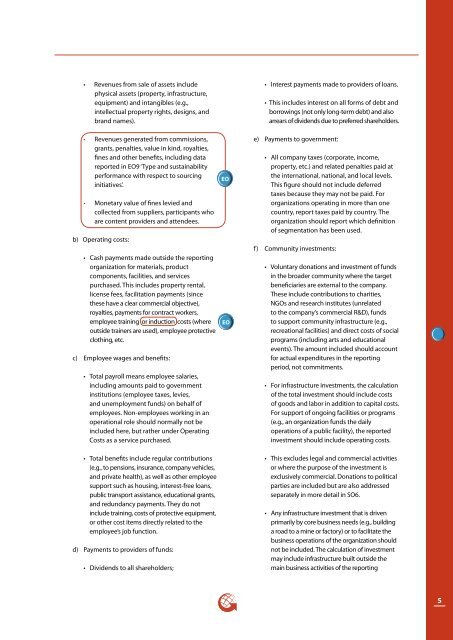Event Organizers Sector Supplement - Global Reporting Initiative
Event Organizers Sector Supplement - Global Reporting Initiative
Event Organizers Sector Supplement - Global Reporting Initiative
You also want an ePaper? Increase the reach of your titles
YUMPU automatically turns print PDFs into web optimized ePapers that Google loves.
• Revenues from sale of assets include<br />
physical assets (property, infrastructure,<br />
equipment) and intangibles (e.g.,<br />
intellectual property rights, designs, and<br />
brand names).<br />
• Revenues generated from commissions,<br />
grants, penalties, value in kind, royalties,<br />
fines and other benefits, including data<br />
reported in EO9 ‘Type and sustainability<br />
performance with respect to sourcing<br />
initiatives’.<br />
• Monetary value of fines levied and<br />
collected from suppliers, participants who<br />
are content providers and attendees.<br />
b) Operating costs:<br />
• Cash payments made outside the reporting<br />
organization for materials, product<br />
components, facilities, and services<br />
purchased. This includes property rental,<br />
license fees, facilitation payments (since<br />
these have a clear commercial objective),<br />
royalties, payments for contract workers,<br />
employee training or induction costs (where<br />
outside trainers are used), employee protective<br />
clothing, etc.<br />
c) Employee wages and benefits:<br />
• Total payroll means employee salaries,<br />
including amounts paid to government<br />
institutions (employee taxes, levies,<br />
and unemployment funds) on behalf of<br />
employees. Non-employees working in an<br />
operational role should normally not be<br />
included here, but rather under Operating<br />
Costs as a service purchased.<br />
• Total benefits include regular contributions<br />
(e.g., to pensions, insurance, company vehicles,<br />
and private health), as well as other employee<br />
support such as housing, interest-free loans,<br />
public transport assistance, educational grants,<br />
and redundancy payments. They do not<br />
include training, costs of protective equipment,<br />
or other cost items directly related to the<br />
employee’s job function.<br />
d) Payments to providers of funds:<br />
• Dividends to all shareholders;<br />
EO<br />
EO<br />
• Interest payments made to providers of loans.<br />
• This includes interest on all forms of debt and<br />
borrowings (not only long-term debt) and also<br />
arrears of dividends due to preferred shareholders.<br />
e) Payments to government:<br />
• All company taxes (corporate, income,<br />
property, etc.) and related penalties paid at<br />
the international, national, and local levels.<br />
This figure should not include deferred<br />
taxes because they may not be paid. For<br />
organizations operating in more than one<br />
country, report taxes paid by country. The<br />
organization should report which definition<br />
of segmentation has been used.<br />
f) Community investments:<br />
• Voluntary donations and investment of funds<br />
in the broader community where the target<br />
beneficiaries are external to the company.<br />
These include contributions to charities,<br />
NGOs and research institutes (unrelated<br />
to the company’s commercial R&D), funds<br />
to support community infrastructure (e.g.,<br />
recreational facilities) and direct costs of social<br />
programs (including arts and educational<br />
events). The amount included should account<br />
for actual expenditures in the reporting<br />
period, not commitments.<br />
• For infrastructure investments, the calculation<br />
of the total investment should include costs<br />
of goods and labor in addition to capital costs.<br />
For support of ongoing facilities or programs<br />
(e.g., an organization funds the daily<br />
operations of a public facility), the reported<br />
investment should include operating costs.<br />
• This excludes legal and commercial activities<br />
or where the purpose of the investment is<br />
exclusively commercial. Donations to political<br />
parties are included but are also addressed<br />
separately in more detail in SO6.<br />
• Any infrastructure investment that is driven<br />
primarily by core business needs (e.g., building<br />
a road to a mine or factory) or to facilitate the<br />
business operations of the organization should<br />
not be included. The calculation of investment<br />
may include infrastructure built outside the<br />
main business activities of the reporting<br />
5

















